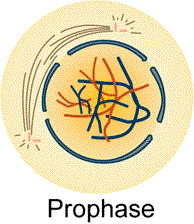
Answer to preceding question.
Early Late
Late
Prophase - Examine the figures above and write in your notes
the activities listed below which occur during prophase of
mitosis. In these figures there are three homologous pairs of chromosomes
(total of six chromosomes). The short red and blue make up one pair,
the medium red and blue make up the second pair and the long red and blue
make up the third pair. Locate these in the figure to the left.
1. Nuclear membrane pulls apart and becomes part of the E.R. and the
nucleoli dissolves
(disappears). Note in later figure.
2. Each long DNA molecule in the form of chromatin twists and coils
back on itself to form rod shaped
chromosomes.
3. Centrioles separate and a new centriole develops at the base of each
parent centriole forming two
centriole organizing centers. These centriole organizing
centers than migrate to poles on opposite
sides of the nucleus.
4. Spindle apparatus forms from microtubules. Spindles will form between
centromeres of each
chromosome and each centrilole organizing center.
Also spindles will form between both centriole
organizing centers. The spindles which radiate
out behind the centrioles are called asters.
Study the figures showing prophase indicated by G-5
readings.
WRITE THESE IN YOU NOTES.
You must answer the question below correctly to move to the next page.
How many chromosomes are in the prophase figures above?
a ) 3
c ) 12
b ) 6
d ) 24
For information on how to use this page, go to How
to Use This Site.
Created by the Center for Learning Technologies, Academic Technology Services.
Last modified October 22, 1997.